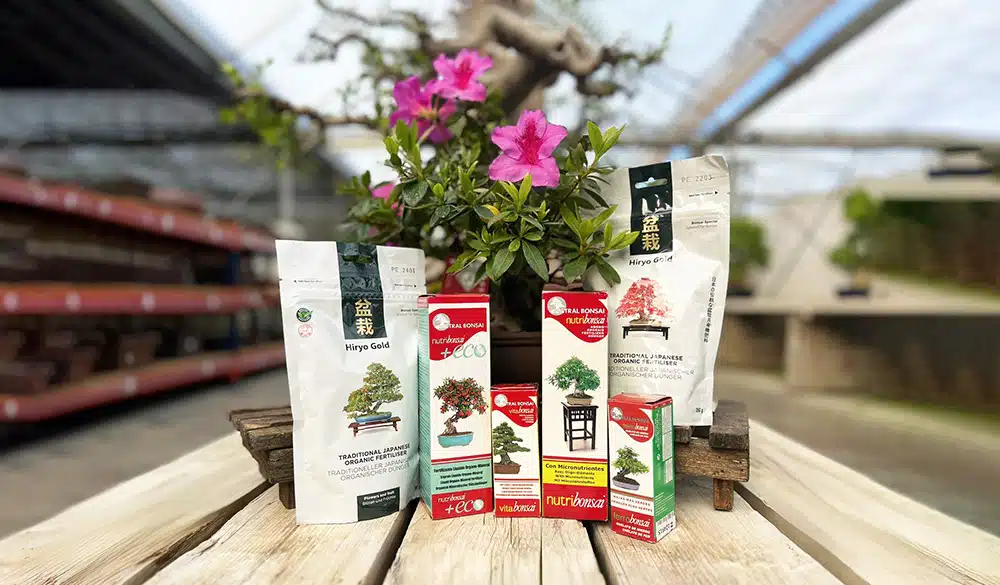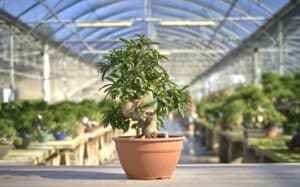The secret of bonsai fertilisation, the power of NPK

When we move into the bonsai growing world, we come across terms and concepts that are essential to guarantee the healthy growth of these little wonders. One of these essential concepts is NPK, which refers to the three main nutrients that every bonsai needs: Nitrogen (N), Phosphorus (P) and Potassium (K). But, what exactly does this mean and why is it so important for your bonsai? We are going to explain it in a simple and easy understandable way. Let’s know the secret of bonsai fertilisation.
NPK: The three essentials of Bonsai nutrition
Imagine for a moment that your bonsai is an athlete in training, and each of these nutrients is a different food that will help him to improve in different capacities.
Nitrogen (N): The muscle builder
The nitrogen is like protein for athletes; it helps in building the “muscles” of your bonsai, which in this case are its leaves and stems. A bonsai with sufficient nitrogen will grow with rich green foliage and vigorous growth. It is the nutrient that your bonsai needs the most during the active growth periods, especially in spring and summer.
Phosphorus (P): The roots and flowers architect
The phosphorus acts as an architect that builds and strengths the internal structure of the bonsai. It stimulates the development of strong roots, which is essential for a bonsai, as a healthy root system is the basis for a healthy tree. In addition, phosphorus is essential for flowering, so if you dream of a bonsai that is not only green, but also has beautiful flowers, you should not ignore this nutrient.
Potassium (K): The plant bodyguard
The potassium is the bodyguard that protects your bonsai from diseases and stress. It helps to regulate vital functions in the plant, by strengthening its immune system and increasing its resistance to adverse climatic conditions such as intense cold or drought. A bonsai with enough potassium is a bonsai ready to face challenges. In addition, potassium is essential for the flowering and fruiting process, being essential for fruit development and maturation.
How to apply your NPK knowledge to the care of your bonsai? The secret of bonsai fertilisation
Each bag of fertiliser will include a set of three numbers (for example, 10-10-10), which represent the percentages of Nitrogen, Phosphorus and Potassium respectively. Choosing the right fertiliser involves understanding what your bonsai needs most in each moment.
Active growth period
Opt for fertilisers with a higher first number (more nitrogen) to stimulate foliage growth.
Preparation for flowering or root strengthening
Look for a fertiliser with a higher second number (more phosphorus).
Improve resistance and general health
A fertiliser with a high third number (more potassium) will be your ally. NPK is not only a set of letters and numbers on a bag of fertiliser; it is a formula that, with proper understanding and application, can change your bonsai growing experience. Like an athlete needs a well-balanced diet to perform at his or her best, your bonsai needs a balance of nitrogen, phosphorus and potassium to grow strong, healthy and beautiful. Remember, the goal is to know and respond to the specific needs of your bonsai at each stage of its life. With patience, observation and a little NPK science in your arsenal, you will be well-equipped to care for your little wonder.
Beyond NPK: Micronutrients
In addition to the essential macronutrients (NPK) for bonsai growth, there is an equally vital world of micronutrients that, although in smaller quantities, play an essential role in the health and development of these plants. These elements, such as Iron, Calcium, Magnesium, Zinc, Boron, Manganese, Molybdenum and Copper, are indispensable for the metabolic processes that enable the plant growth, flowering and resistance to disease. For example, Iron is essential for the formation of chlorophyll, essential for photosynthesis and the intense green colour of leaves; while Calcium is a key to the structural development of cell walls, and Magnesium, a central component of chlorophyll, facilitates the absorption of light.
Although NPK fertilisers usually include an appropriate ratio of these micronutrients, sometimes plants may experience specific deficiencies that affect their development and aesthetics, such as iron chlorosis, an iron deficiency that manifests itself in a yellowing of the leaves. For these situations, the market offers specific deficiency correctors that can be applied to solve these deficiencies. A good choice of corrector can be Ferrobonsai.
So it is important not only to focus on the main nutrients but also to be aware of the signs that our plants are sending us, indicating a possible lack of these essential micronutrients. The inclusion of a balanced fertiliser, supplemented with deficiency correctors where necessary, ensures the maintenance of a healthy, strong and aesthetically pleasing bonsai.
About the Author
Mistral Bonsai
In Mistral Bonsai we are a communication team, technicians and masters committed from the first day to disseminating the wonderful art of bonsai. A world that offers many things to share. We believe that a bonsai is a tree with a soul, unique and unrepeatable. Another of our most essential pillars is, how could it be otherwise, our close commitment to the preservation of the environment and nature.
Categories
Bonsai cultivation and care (60)
Bonsai gift (2)
Bonsai pests and diseases (7)
Bonsai repotting (3)
Bonsai species (1)
bonsai substrates (2)
Bonsai summer (1)
bonsai tools (1)
Bonsai work (13)
Ceramic pots (3)
Chinese culture (2)
Chinese culture (1)
Coniferous bonsai (2)
Conifers (1)

